General Principles of Harmony – Coherence and Continuity
Most discussions of harmonic coherence in the common practice period center on tonality. Outside of this period, explanations emphasize relationships of chordal identity or similarity. This is a significant – and usually unnoticed – distinction. Tonality helps create musical motion, since it defines goals. A tonal progression cannot be scrambled and maintain its integrity. In the absence of tonality, analysis based only on relationships of identity or similarity overemphasizes the “what”, as opposed to the “when”. Pointing out pitch cells or algorithms which give rise to all of the pitch material in a work can never adequately explain why a work’s harmonic construction is convincing, since music is a temporal art; the sequence of events is essential to its meaning. Even in music without a clear tonic, context radically changes musical meaning. A chord at the climax of a phrase is not equivalent to the same chord at the start of another phrase, since much of its meaning derives from how it is approached and left.

Here, the chord marked “x” is identical in both examples. However, in the first example it is clearly a subsidiary, passing chord: It is rhythmically weak, introduces no new notes, and helps to fill in the space between the chords under the slur. The real accent here is on the last chord, which no longer stays in the D major scale, and has a richer interval (a 6th) on the bottom. In the second example, the same chord is now the climax of the phrase. Not only is it rhythmically accented and longer in duration, but it also culminates a progression of rising harmonic tension. The preceding chords alternate between gentle sonorities, (i.e. without semitone dissonances) and harsher ones (i.e. each containing one such dissonance). The last chord contains two semitone relationships, making it, in this context, a stronger accent.
A more useful way to think about harmonic coherence is as one aspect of a leading thread for the listener to follow as the piece progresses. This formulation does not require that the harmony be based on classical tonal relationships. It also links the notions of coherence and flow, which, in a temporal art, are profoundly connected. The deeper question becomes: How does the harmony engage the listener in the music’s flow in compelling ways? Harmonic coherence, seen in this way, has several aspects which we will explore below.
PITCH AND INTERVAL LIMITATIONS: FAMILIES OF CHORDS
As already pointed out, an important aspect of harmonic coherence is limiting the work’s pitch content. Establishing such harmonic limits, which engender norms, makes it easier to create harmonic expectations. Such expectations direct and intensify the listener’s experience of musical time.
Such harmonic norms generally involve creating “families” of chords. A family is any group of chords with clearly audible resemblances. To carry the analogy farther, a family can include many members who share some obvious characteristics, but who are also more or less individual. This notion has the advantage of allowing for many degrees of relationship.
To give only a few examples, families could be organized by:
- Basing the music on a given scale or mode.
- Using persistent common tones, especially in the same octave: This generates the simplest kind of audible coherence. It corresponds to the classical pedal point.

In this example, the clarinet tremolo, E-G#, acts like a classical pedal point, providing simple, clear, registral, rhythmic, and harmonic unity. However, the outer parts also contribute to coherence. The flute part starts the first two phrases with the same three notes which emphasize B as a stable tone. This causes the final cadence note, A#, to sound like a lower neighbor. Similarly, the highest note in the first bar, A#, leads stepwise to the highest note in the second bar, B. The oboe part is homorhythmic with, and has similar voice leading to, the flute part: The D# and C in the first bar remain in the second bar; the E of the first bar is “ornamented” by the F# in the second, and the E in the last bar seems to “resolve” the previous D#. The harp is limited to 4 notes.The last bar sounds cadential because of the less animated rhythm, the on-the-beat accent, the softer harmony (which avoids semitone conflicts) and the descent of the harp into a new register. While the common tones in each instrument certainly help to hold the phrase together, we can see that these various other relationships – in rhythm, voice leading, and interval tension – also help the listener to make sense of the whole. Identity relationships are thus only one aspect of a more complex coherence.
- Intervallic harmony: Transposed intervals are much less easily identified by a naive listener than simple common tones, since the common element is a relationship. However, limiting the intervals used in a given passage to one single interval (and its inversion) can define a strong, audible character. Similarly, limiting a passage or a piece to material derived from a small unordered cell (“unordered set” in the literature) can also create fairly strong character. (Note that the larger the cell, the more intervals it contains, and therefore the less distinctive it becomes. If more than three or four intervals are involved, the cell will usually contain all of the chromatic intervals – being unordered, non-adjacent intervals must be counted as well. This is where Forte’s notion of “interval vector”, i.e. the total number of times a given interval appears within a given set, is useful. Sets with very uneven distributions of intervals tend to have clearer characters.) These techniques can be applied quite rigorously for short passages, or more flexibly over larger stretches (see below for discussion of this important distinction). Flexible applications usually involve either melodic movements which create other intervals as “non-harmonic tones”, or vertical stacking, which necessarily results in richer chords. Since stacks of any one interval almost always produce additional, new intervals between non-adjacent notes, this technique allows for harmonic “shading”, i.e. moving between sonorities which are highly saturated with the main interval to others where its effect is less prominent.
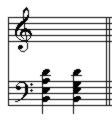
In this example, the first chord is a simple quartal sonority. The outer notes, however, form a 3rd. Thus it is easy to move from the first chord to the second one, which is triadic, via the the smooth stepwise movement from A to G. The second chord could subsequently either return to the first, acting like a neighbor chord in a generally quartal passage, or else lead into a passage of tertian harmony.
- Since intervals have distinct tension characteristics, using chords with common tension configurations (e.g. one harsh dissonance plus one rich consonance) can unify a passage. Likewise, progressions of tension, e.g. from rich consonance to sharp dissonance, are easily followed by the listener.
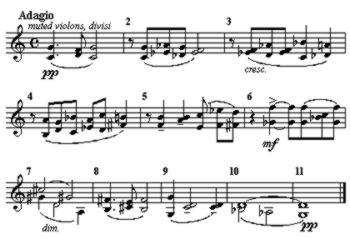
This example illustrates a gradual progression from gentle, open intervals to an intense climax on a major 7th (m. 6), and then back. The dynamics and registral evolution reinforce this progression. Note that the progression is not simplistically linear: Overly obvious progressions tend to be boring. The best strategy is for the overall direction to be well defined, while the details remain somewhat unpredictable: The general direction of the progression allows the listener to develop expectations, but the inability to predict the exact next note maintains interest.
A family often will contain chords associated in more than one way (e.g. through both common intervals and common register). This is logical, since simple voice leading tends to keep parts in one register, or at least to change register without discontinuity. The more elements which are kept common within a harmonic family, the easier the harmonic character will be to perceive. This is yet another example of how critical it is for the composer to accurately judge degrees of salience; only in this way can he exercise subtle control over audible gradations of harmonic continuity and contrast.
LINEAR ASPECTS: MELODY AND BASS LINES; VOICE LEADING
We have pointed out above how pitch and interval limitations help define and unify harmonic character.
Two other traditional concepts contribute significantly to harmonic coherence: leading lines, and voice leading.
Even in contrapuntal textures, all parts are never of equal importance: Interest migrates from one part to another. In simpler, homophonic textures, outer parts are easier to follow than inner parts. Thus, clear linear progressions in the outer parts can clarify the music’s sense of direction. For example, a melodic line which gradually attains higher and higher local peaks, leading to a sectional climax, helps give coherent shape to a musical paragraph. In the same way, the combination of stepwise motion in the bass with occasional angular passages – often at cadences – helps clarify harmonic direction.
Voice leading is always a very audible force, both for harmonic continuity and for articulation. The basic principles of voice leading arise from two fundamental facts (for experimental documentation, see Albert Bergman’s Auditory Scene Analysis): the tendency of the ear to separate musical strands by register, and the fact that voices, and most instruments, are most at ease moving by fairly small intervals. These are facts about human hearing, and they therefore go beyond specific styles. Constantly leaping lines are very demanding to follow and to sing. By contrast, registral continuity, as expressed by common tones, conjunct movement, and stepwise movement between salient tones in the line, are easier to follow and provide the “glue”, connecting one harmony to the next.
An important consequence of the importance of registral continuity is that ornamental (non-harmonic) tones arise from the nature of hearing, since they are virtually always stepwise. They are not just a stylistic peculiarity of tonal music. The fact that many systems for controlling pitch in non-tonal situations do not allow for them is a serious limitation: It deprives the composer of an effective means of creating leading lines which are easy to follow.
AN ASIDE: OPEN VS. CLOSED HARMONIC SYSTEMS
This leads us to an important distinction: open systems vs. closed systems. An open system imposes audible, but not rigid, constraints, providing aural coherence, while allowing the composer’s melodic imagination more freedom. Closed systems are much more mechanical, limiting the composer’s options at any given moment in quite rigid ways. The distinction is largely one of degree.
Advantages of open systems include:
- Because most of them came about through evolution, rather than invention, they have usually been “survival-tested” by ear: Evolution tends to filter out approaches which are not effective.
- They are flexible. Contrary to many invented twentieth century systems, they require only a reasonable preponderance of their normative sonorities, rather than 100% saturation. They thus allow the composer’s ear to work in more intuitive ways and do not automatically constrain basic linear impulses, such as conjunct lines. There is no inherent contradiction between non-harmonic tones and coherent, non-tonal music. For example, a piece using a core harmonic cell at key points could allow for non-harmonic tones between them. As long as the rhythm and phrasing make it clear which sonorities are the structural “pillars”, and as long as there are enough such pillars – reference points – to stimulate the memory reasonably frequently, there is no more need for such harmony to derive every note from the basic cell than for classical harmony to insist that every non-harmonic tone be part of a triad.
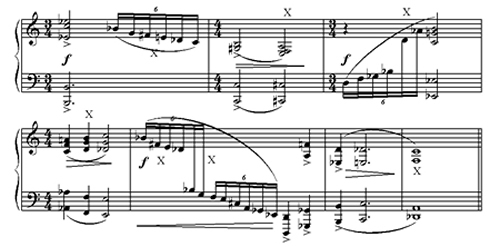
This example is based on the three note (unordered) harmonic cell: B-C-Eb. The places marked “X” contain intervals not in the cell: major 2nd, perfect 4th, tritone. However, the cell is still very prominent overall, and these “exceptions” are not musically salient. They are easily heard as simple passing or other ornamental movements.
Apart from the flexible kind of cellular harmony seen in the example above, other examples of open systems include:
- Families of chords, as defined above.
- Added note chords.
- Polyharmony.
- Stratified harmony, i.e. harmonic textures where richness comes from simultaneous, but clearly differentiated harmonic strands. A fuller discussion of this technique will be found **URL TO BE UPDATEDbk.H/H-6.html#Harmony with multiple planes of tone”>below. (Note that polyharmony can also be considered a kind of stratified harmony, if the layers are timbrally and/or rhythmically well distinguished.)
All of these techniques create recognizable harmonic worlds, while allowing the composer a great deal of local choice.
Closed systems, by contrast, severely limit the choice of notes available. Worse, they often do so to the extent that the expressive intentions of the composer cannot be fulfilled while respecting the limits of the system.
Examples of closed systems include: most algorithmic, total serial, and rigid mirror procedures. The key feature of such systems is that they do not allow the composer’s inner ear to follow its own impulses at every point. While an open system imposes just enough limitation to create a coherent sound world, the 100% saturation imposed by a closed system makes for easy analysis, but usually has very little to do with how people actually hear. If the ear is to remain paramount for both composer and listener, why waste effort creating inaudible connections, and excluding audible ones which do not weaken aural coherence?
Much serial technique has long created problems of this sort, since the “order” in question usually has nothing to do with what can be reliably heard, even by an experienced, attentive listener. Further, chords in serial music inevitably create interval combinations not inherent in the row. And in any case, what is the meaning of “order” in a chord whose notes are heard simultaneously? (Of course, these comments do not imply that no serial music is of any value, but just that serial procedures easily lead to unmusical thinking.)
HIERARCHY, LANDMARKS, CADENCES
Apart from family resemblances, classical tonality provides an example of another important principle of harmonic coherence: hierarchy. The idea of “leading lines”, already discussed above, provides a simple application of this notion to simultaneous strands of the musical texture. Applied to successive phrases, sections, etc., hierarchy likewise makes the listener’s task much easier, by organizing larger spans into sub-sections, whose limits and relationships to each other are easier to grasp. Hierarchy, in short, makes possible richer and more complex musical structures.
We will first discuss the hierarchical functions of tonality, and then discuss how similar effects can be achieved without it.
Hierarchy applies on several levels. First, tonality itself is based on scales with unequal intervals: If all intervals are equal, there is no harmonic reason why one note will sound more final than any other. Within unequal scales, differences in intervals create points of relative stability and attraction. For example, in major and minor scales, the semitones are points of attraction; the leading tone is a familiar example.
On a higher level, as Schoenberg points out, music requires articulation into units that can be assimilated by the memory in order to remain comprehensible (e.g. phrases, sections, etc.). Such articulation is the function of cadences. Cadences are necessary, whatever the harmonic language used.
If the listener is to follow music of any length, he requires gradations of cadence. Such variety of punctuation makes phrase divisions easier to perceive, and clarifies their relationship to one another: Hierarchical tonal cadences tell the listener how far away he is from “home”, i.e. the tonic. In tonal music, this hierarchy of cadences is well known, and need not be listed here.
On an even higher level, not only does a tonal center provide a useful point of reference, but it also allows for the creation of secondary centers, permitting still more degrees of punctuation, thus making large-scale coherence easier to grasp.
This points out the necessity of audibly underlining important notes and chords, in effect treating what happens between them as ornamentation (or, to use the Schenkerian term, prolongation). This kind of salient, musical “highlighting” makes it easier for the listener to parse large forms by ensuring that landmarks are easily noticed, and memorable.
These distinctions between harmonic reference points and harmonic ornamentation, and the way reference points are approached and left – in other words the way they are pointed out to the listener – are critical for understanding the interaction between harmony and form. Even in elementary tonal harmony, the tonic will often not be recognizable after substantial harmonic digression, unless it is thus made salient, through coordination with other aspects of the music. (How many people notice that many classical operas – for example, Mozart’s Magic Flute – do not end in the same key in which they start?) Such salience can be achieved by:
- Accent: extremes of pitch, strong contrast of duration or orchestration.
- Building up to such important moments, with crescendi, rising lines, gradual tempo change.
- Repetition, for emphasis.
- Directed cadential progressions.
- Isolation: framing by silence.
Without such cues, one must assume that listeners somehow memorize the absolute pitch of a work’s tonic, and remember it despite all intervening harmonic activity. This is patent nonsense.
Incidentally, this more realistic view of tonality also sheds light on what Robert Simpson, in his book Carl Nielsen, Symphonist, calls “progressive tonality”. This phenomenon appears in composers like Nielsen and Mahler, where movements sometimes finish in a different key from where they begin. The interesting point about such forms is not simply that they do not end where they begin, but that they dramatize the search for a new tonic. As Simpson shows, the first movement in Nielsen’s fifth symphony is a fine example of this procedure.
How can the composer create cadences and cadential hierarchy in the absence of classical tonality?
First, all cadences, in any style, imply coordination of harmony with rhythmic resolution and accent. Even in classical tonal harmony, often the only difference between V-I progressions within a phrase and those at the cadence is rhythmic. Strong cadences combine pitch resolution with rhythmic resolution. While it is harder to achieve a sense of cadence without a regular beat, cadence still will coincide with a sense of rhythmic arrival, or at least break or dilute the rhythmic flow.
Here are some other aspects of the notion of cadence which can be generalized:
- A cadence always represents a change in the tension level, most commonly a reduction: The Latin “cadere” means “to fall”. Falling lines usually sound like endings, perhaps by analogy with the tendency of the human voice to fall at the end of sentences.

Here, cadence is created by the combination of: a falling line, a reduction in interval tension, and rhythmic slowing down.
- Since “articulation” means setting something apart, cadence is signaled by doing something different from what precedes it (i.e. deviating from some established harmonic pattern). For example, a phrase with a stepwise bass may become more angular, or vice versa. Established harmonic rhythm often changes at the cadence. Both of these techniques require some harmonic regularity and predictability during the phrase. (Incidentally, such changes can also be used to indicate climaxes; however, the latter are associated with increasing intensity rather than reduced tension. A cadence can also be climactic.)
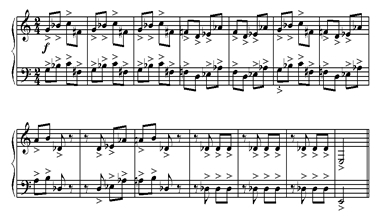
In this example, cadence is achieved by the arrival of a fresh note (E), as well as by an accented leap into a new, lower register. Also, the many repetitions in the preceding measures create a rather slow harmonic rhythm, so that the final novelty is even more marked. Note how the drive to the last note is reinforced by a crescendo.
- A cadence provides resolution or culmination – at least locally – of directional forces. Progressions (using the term as defined earlier) established within the phrase are culminated or dissipated.
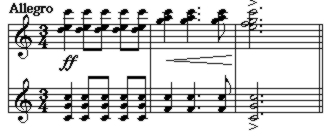
The main elements which make the last chord here sound final are: its rhythmically accented position, its duration, and the fact that it contains a cluster, for the first time including a semitone. This cluster creates greater tension (accent): There is a progression in the level of dissonance.
- If unequal scales are used, the smallest intervals can create an effect analogous to leading tones.

The scale on which this theme is based (E-F-G#-B-C#-D#) provides two semitone relationships, above and below E. This makes the cadence’s direction clear, since the two semitones are prominently placed, right before it.
- An acoustically clear interval, like a 5th or an 8ve in the bass can help establish stability at the cadence.
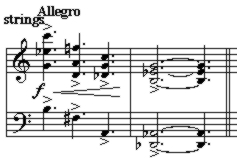
Here, the low fifth in the final chord, combined with its longer duration, and the fact that it culminates a falling gesture, make for clear resolution.
As for hierarchy in non-tonal contexts, tonal polarity – the establishment of secondary centers – can fill this structural function, as can: varying degrees of rhythmic stopping, and the use of mitigating factors during cadences (e.g. motivic anticipation of the next phrase, elision, etc.). The important thing here is that the technique chosen must allow for easily audible gradations.
Compare the two cadences for the following phrase:

Phrases “A” and “B” differ only in their final chord. Phrase “B” sounds more final than phrase “A” because the final chord contains more common tones between the two hands, reducing harmonic tension in this generally polychordal context.
